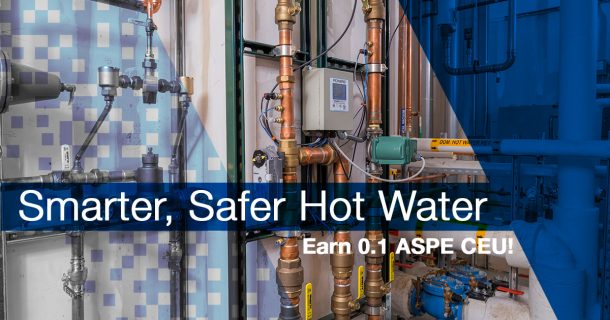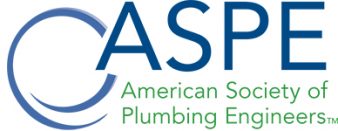MILWAUKEE, Wis.—A. O. Smith, a Milwaukee-based manufacturer of residential and commercial water heaters, boilers and water treatment products, announced the beginning of its plans for integrating their most recent acquisition into its North American Water Treatment (NAWT) division. NAWT includes A. O. Smith branded water filtration and softening products, Aquasana based in Austin, Texas, Hague Read more
hot water
MILWAUKEE, Wis.—A. O. Smith, a Milwaukee-based manufacturer of residential and commercial water heaters, boilers and water treatment products, announced the beginning of its plans for integrating their most recent acquisition into its North American Water Treatment (NAWT) division. NAWT includes A. O. Smith branded water filtration and softening products, Aquasana based in Austin, Texas, Hague Quality Water based in Columbus, Ohio, and Water-Right based in Appleton, Wisconsin, and acquired by A. O. Smith in April of 2019.
Sam Karge, a Senior Vice President at A. O. Smith and President of NAWT, outlines his excitement for the collaboration within the division.
“These are truly bright, new ideas that have come out of our discussions as a team. Every company that has been brought together to form NAWT has a reputation for innovation and combining our teams is just one more innovative way that we can better serve our customers.”
Luke Java, the Director of Sales & Marketing for Water-Right, Inc., will assume the role of managing the Hague Quality Water regional sales personnel in addition to the Water-Right regional sales personnel. This move will create a central point of leadership for both sales and marketing teams, allowing better allocation of resources and providing even stronger customer support coverage.
The former sales manager for Hague, Jared Camacho, will be shifting his efforts to become the national manager of water softener Retail Sales Accounts, reporting to the Vice President of Sales and General Manager of Indirect Sales for A. O. Smith. This role will manage and further expand the retail market channel in North America.
Erik Koglin, formally the Field Manager of the Clear Choice Water Group at Water-Right, will now assist in managing the dealer networks for both Water-Right and Hague as a National Channel Manager. As the NAWT members begin to become more integrated, the role of the National Channel Manager will become important in facilitating coordination among the variety of branded dealerships within specific regions across the country. All of the dealer’s independently owned businesses dedicated to these branded networks will continue to operate as usual.
Kevin Osborn, the northeast Regional Sales Manager for Water-Right, will be taking on the role of account manager for Hague dealers in the New England territory. This will fill a formerly vacant role in the area while working to facilitate efforts between Water-Right and Hague dealers in that area.

Watts has announced the next installment in a series of webinars for their engineer, architect, designer, and facility manager customers: Smarter, Safer Hot Water, to be broadcast live on Wednesday, August 28, 2019. This latest webinar will focus on how digital mixing valves enable engineers, designers, and facility managers to directly measure, monitor, and deliver Read more
Watts has announced the next installment in a series of webinars for their engineer, architect, designer, and facility manager customers: Smarter, Safer Hot Water, to be broadcast live on Wednesday, August 28, 2019.
 This latest webinar will focus on how digital mixing valves enable engineers, designers, and facility managers to directly measure, monitor, and deliver safer hot water through domestic water systems.
This latest webinar will focus on how digital mixing valves enable engineers, designers, and facility managers to directly measure, monitor, and deliver safer hot water through domestic water systems.
Key points to be covered include an overview of how digital mixing valves:
- Efficiently deliver mixed water throughout a hot water recirculation loop while allowing remote monitoring and control of water temperatures,
- Minimize the risk of waterborne bacteria in high-performance commercial and institutional facilities, and
- Provide precise control needed to deliver high water temperatures that mitigate the risk of the deadly Legionella bacteria (the cause of Legionnaires’ disease) while avoiding the risk of scalding and thermal shock injuries.
By attending the entire webinar, attendees can receive 0.1 Continuing Education Units (CEUs) through the American Society of Plumbing Engineers (ASPE).
To register for this webinar, please visit this page.
The American Society of Plumbing Engineers (ASPE) is seeking volunteers with a technical background in designing plumbing systems, specifically domestic water heating systems, to participate on Working Group 15 to develop a new American National Standard on system design methods used to regulate the temperature of water exiting a fixture or appliance in domestic water Read more
 The American Society of Plumbing Engineers (ASPE) is seeking volunteers with a technical background in designing plumbing systems, specifically domestic water heating systems, to participate on Working Group 15 to develop a new American National Standard on system design methods used to regulate the temperature of water exiting a fixture or appliance in domestic water distribution systems. Ideal candidates would be plumbing system designers/engineers, piping system experts, code authorities, and others knowledgeable in plumbing system design techniques.
The American Society of Plumbing Engineers (ASPE) is seeking volunteers with a technical background in designing plumbing systems, specifically domestic water heating systems, to participate on Working Group 15 to develop a new American National Standard on system design methods used to regulate the temperature of water exiting a fixture or appliance in domestic water distribution systems. Ideal candidates would be plumbing system designers/engineers, piping system experts, code authorities, and others knowledgeable in plumbing system design techniques.
ASPE 15 is intended to reduce the potential for hot water scalds and related injuries, as well as reduce the risk of thermal shock due to pressure disturbances within the domestic water distribution system. It will fill a void that exists in current product standards by addressing the total system design from the point of entry, through the distribution system, and to the point of use.
The deadline to apply is May 10, 2019. Interested individuals are encouraged to fill out the application here: ASPE Standards Committee Application. For more information, please contact WG 15 Chair, Chris Haldiman, at Chris.Haldiman@wattswater.com or ASPE Sr. Director of Technical & Regulatory Affairs, Ramiro Mata, at rmata@aspe.org.
The CB Series of Combination (Combi) Boilers from Noritz is a year-round, whole-home solution that utilizes high-efficiency condensing technology to deliver hot water to both plumbing and hydronic heating applications, including those in colder climates. The CB Combi performs at a 95% AFUE (Annual Fuel Utilization Efficiency); that is, 95% of the Btuh input is Read more
The CB Series of Combination (Combi) Boilers from Noritz is a year-round, whole-home solution that utilizes high-efficiency condensing technology to deliver hot water to both plumbing and hydronic heating applications, including those in colder climates.
The CB Combi performs at a 95% AFUE (Annual Fuel Utilization Efficiency); that is, 95% of the Btuh input is converted into useable heat, making it an extremely energy-efficient appliance. This fuel-saving performance meets “Energy Star Most Efficient” standards, which represent the EPA’s highest efficiency rating and allow homeowners to qualify for various state energy rebates.Delivering up to 9.2 gallons per minute of domestic hot water, the CB Combi provides nearly twice as much flow as competitor models. A flow control valve, not offered by competitors, ensures a consistent temperature for domestic hot water demand, regardless of incoming water temperature. This allows greater domestic hot water flow and more precise temperature stability, translating to a higher level of customer satisfaction.On the space heating side, the Combi accommodates a host of multiple-room applications including radiators, baseboards, low- and high-mass radiant heating (i.e. in-floor, snow melt, etc.) and air handlers.Two models are available for different levels of demand:
- The CB180DV has a maximum gas input Btuh of 180,000 for hot water and 100,000 Btuh for space heating.
- The CB199DV has a maximum gas input Btuh of 199,000 for hot water and 120,000 Btuh for space heating.
Other CB Combi features include:
- A compact wall-hung package weighing only 90 pounds, making it lighter than a traditional boiler so that a single installer can do the job. Its compact size allows it to take up as much as 80 percent less space than a traditional floor-standing boiler and water heater.
- An outdoor temperature reset sensor that measures outdoor temperatures, allowing the CB Combi to constantly operate at maximum efficiency.
- Different temperature settings for the domestic hot water heating and space heating applications. For domestic hot water, temperatures range from 90 to 140 degrees Fahrenheit. On the space heating side, the range is 100 to 180 degrees Fahrenheit.
- A built-in external pump control that allows for an external secondary or booster pump to be wired directly to the Combi to deliver significantly more BTU’s on the primary loop without sacrificing efficiency.
- Three Austenite stainless steel heat exchangers that deliver superior performance and a longer life and scald prevention technology that ensures domestic hot water safety.
- Condensing technology with low enough exhaust temperatures to allow venting with PVC, CPVC or PP. The use of plastic venting materials – rather than the stainless steel venting required by non-condensing water heaters – substantially lowers costs by reducing installation time as well as the cost of the materials themselves.
The compact size, ease-of-installation, high-efficiency and superior domestic hot water performance of the Noritz CB Combi add up to an all-in-one solution for a home’s heating and hot water needs.
Water heater manufacturers appear to be well-prepared for new energy-efficiency rules from the U.S. Department of Energy (DOE) that will take effect on April 16. However, many plumbing contractors, designers and engineers are still assessing how the new requirements will affect the replacement, remodeling and new construction markets. “Contracting firms will need to get their Read more
Water heater manufacturers appear to be well-prepared for new energy-efficiency rules from the U.S. Department of Energy (DOE) that will take effect on April 16. However, many plumbing contractors, designers and engineers are still assessing how the new requirements will affect the replacement, remodeling and new construction markets.
“Contracting firms will need to get their employees up to speed on the new technologies,” said Chad Sanborn, product marketing manager, Bradford White, in an interview with Perspective Media. “Training on the new products will be critical, as well as education on the details and reason for the change.”
Leading manufacturers like Bradford White, Rheem and A.O. Smith have been developing new models and platforms for several years in preparation for the new standards incorporated in the National Appliance Energy Conservation Act (NAECA). “Along with launching a new product line, we have also been educating customers and consumers in order to make this transition as smooth as possible,” said Stacey Gearhart, director of product and channel marketing for Rheem’s Water Heating Division, in a recent interview. “Our industry is absolutely ready for April 16.”
The new DOE rules mandate higher energy factor (EF) ratings on virtually all residential water heating products, including gas-fired, oil-fired, electric, tabletop, instantaneous gas-fired and instantaneous electric.
While all affected models will see an increase in the EF requirement, the most dramatic changes are in larger capacity models (see accompanying chart). That’s because the only technologies that meet the EF requirements over 55 gallons are electric heat pump water heaters and high-efficiency condensing gas water heaters.
The DOE estimates that the new 2015 standards will result in approximately $63 billion in energy bill savings for products shipped from 2015-2044. The standard will avoid about 172.5 million metric tons of carbon dioxide emissions, equivalent to the annual greenhouse gas emissions of about 33.8 million automobiles.
“Homeowners will have a lot to gain from the new NAECA guidelines with some saving as much as $365 per year in energy bills,” said Sanborn. “On the other hand, a new type of water heater may need to be considered in order to meet the NAECA guidelines.”
While the operating cost of the new water heaters will be less because of their increased energy efficiency, the homeowner’s maintenance costs may be affected by other factors, such as the integration of electronics, blowers, fans, condensers, or other components.
Another potential drawback is that a new water heater is likely to have lower hot water deliverability than prior models. “For example, a model with less input may be required to achieve the higher efficiency, which will ultimately result in less hot water delivered,” Sanborn said.
On the positive side, homeowners the energy savings from the new technology can help offset some of the product and installation costs. Also, some platforms, such as electric heat pump water heaters, may provide supplemental cooling and dehumidification benefits to the owner.
Design and installation issues
While residential consumers will be happy about the prospective cost savings with the energy-efficient technology, plumbing designers and contractors need to consider other issues associated with the changeover. For example, achieving a higher EF rating often means adding more insulation to the tank, making it larger and thicker. In addition, more insulation may be required for piping and fittings.
Therefore, a post-April 2015 water heater may be larger than the current model and require more space for a replacement or a new installation. “In some rare cases, water heaters may have to be moved to another location if their new sizes cannot be accommodated within the current space,” noted Sanborn.
In other cases, multiple tanks might be necessary to deliver an sufficient supply of hot water to the homeowner, added Gearhart.
Another installation issue is that condensing gas water heaters are usually significantly heavier than standard models. They may also require flue dampers or electronic ignition. Oil-fired products may also need extra insulation, as well as flue dampers or new combustion systems. For contractors, that means many installations that were once a one-person job may now require two people. Service trucks may also need to change to accommodate transporting the taller, wider and heavier equipment.”
Because gas water heaters also have electronic control systems and require 120-volt service, contractors may need to purchase multi-meters for smooth installations as well as trouble-shooting. They may also need to price in the additional time and components, including venting materials and condensate pumps when pricing new or replacement jobs.
Designers, engineers and contractors must also adjust their plans for gas-fired models to include a venting system and a drainage system for disposing of condensate. That means the prior location of a water heater may not be the best site for a new model, which typically requires a large room or a duct to an adjoining room. With electronic cycling, the new EF models are also likely to produce more noise than standard models.
The commercial market
In a prior interview, Sanford said the upcoming EF mandate will have little effect on most of the commercial market. “The change only affects water heaters with inputs of 75,000 BTU/hr or less, which are typically installed in residential applications,” he said. “However, some light duty commercial applications, such as small office buildings or small apartment complexes, will fall under this category.”
Since plumbing engineers typically specify commercially rated products on their projects, the impact will be minimal for those installations. However, some small businesses with low hot water demands use a small residential water heater to save on equipment costs.
Large apartment and condo developments will be affected by the new rules if the design calls for individual water heaters for each unit. Builders and developers of these projects will have to work with their designers and architects to make sure residences are designed with adequate space to accommodate the new platforms.
Learn the new landscape
Water heating professionals encourage contractors to learn all they can about the new product lines and the NAECA standards. “Consumers will rely on their contractors to determine how to get the largest amount of hot water for their homes,” said Gearhart. “Becoming familiar with these platforms allows you to determine the best solution for each installation, and answer your customers’ questions.”
Sanford said Bradford White has been sharing information with industry partners and customers since 2011. The manufacturer also opened an International Technical Excellence Center (iTEC ) to help educate customers and business partners about current and future products.
“Along with our manufacturers’ representatives, we have been conducting NAECA seminars for the past three plus years,” he said. During that time, the company has had NAECA information available on its website and distributed more than 100,000 brochures on the topic.
But as recently as the January 2015 AHR show in Chicago, Sanford spoke with some plumbing professionals, who said they were just starting to pay attention to the matter in detail.
Summing up the situation, Sanford said, “Be prepared! If you deal with water heaters on any level and you are not familiar with NAECA and its effect on products, then speak with your preferred manufacturer, wholesaler or professional installer. The new standards will present some challenges, but they will also present opportunities for those who are ready to help their customers through the transition.”
